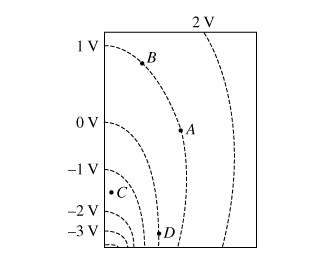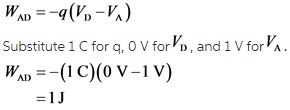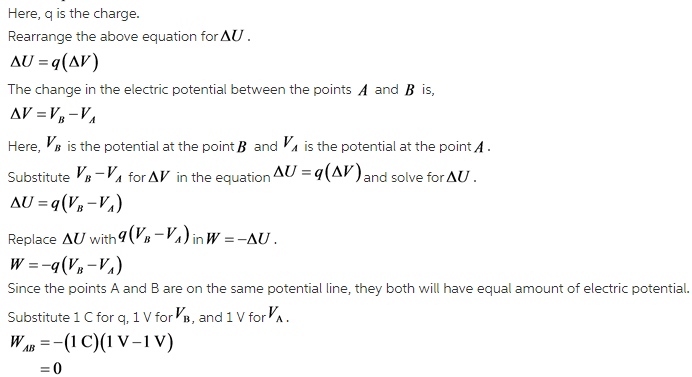The dashed lines in the diagram represent cross sections ofequipotential surfaces drawn in 1- V increments.

What is the work W_AB done by the electric force to move a 1-C charge from A to B?
What is the work W_AD done by the electric force to move a 1-C charge from A to D?
The magnitude of the electric field at pointC is
a) greater than the magnitude of the electric field atpoint B.
b) less than the magnitude of the electric field at point B.
c) equal to the magnitude of the electric field at pointB.
d) unknown because the value of the electric potential at point C is unknown.
Answer:
The potential difference can be expressed as follows:
![]()
Thus, the work done by electric force to move a 1 C of charge from point A to point B is 0 J.
The work is done by the electric force and it is positive. If the work done is positive, then the potential energy of the system decreases. So, the sign of the change in potential energy is negative.
Express the work done in moving the charge between the points A and D as follows:

Thus, the work done by electric force to move 1 C of charge from point A to point D is 1 J.
The points A and D are on the different equipotential surfaces. The point D is on the equipotential surface on which the electric potential on this surface is 0 V. The point A is on the equipotential surface on which the electric potential is 1 V.
The electric field need not be constant over the equipotential surface. The electric field strength is inversely proportional to the spacing between the equipotential surfaces.
The equipotential lines are closer at point C than the equipotential lines at point B.
Hence, the magnitude of electric field at point C is not less than or equal to the magnitude of electric field at point B.
The field strength is stronger where the equipotential lines are closer together and weaker where they are farther apart.
The equipotential lines are closer at point C than that of at point B.
The value of electric potential at point C can be calculated and hence it is a known value.
The equipotential lines are closer at point C than the equipotential lines at point B.
Hence, the magnitude of electric field at point C is greater than the magnitude of electric field at point B.
Thus, the statement magnitude of electric field at point C is greater than the magnitude of electric field at point B is correct.
The field strength is stronger where the equipotential lines are closer together and weaker where they are farther apart.
